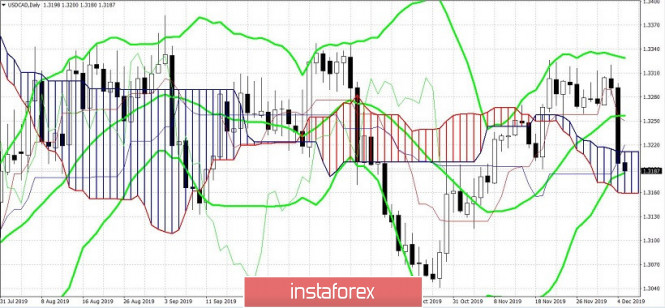The Bank of Canada surprised the market with its hawkish attitude yesterday: contrary to the expectations of most analysts, not only did the regulator not soften the tone of its rhetoric, but also showed optimism regarding the growth prospects of key macro-indicators of the country. Such a scenario came as a surprise to the market, so the loonie instantly collapsed by a hundred points and is currently heading towards the main support level of 1.3150. If the bears overcome it, they will be able to return to the region of the 30th figure, where the pair was for the last time at the end of October.

On the eve of the December meeting, the market was 100% certain that the regulator would leave all the parameters of monetary policy unchanged. At the same time, according to general expectations, the central bank should have taken a dovish position regarding the assessment of its further actions. Some experts argued that the central bank will announce a rate cut in January, while others suggested that the regulator hinted at easing monetary policy in the first half of next year. In other words, almost everyone was convinced that against the backdrop of uncertain prospects for US-Chinese trade negotiations, the Bank of Canada would take at least a defensive position - especially since key economic indicators have recently shown conflicting dynamics.
In particular, the latest labor market data unexpectedly disappointed: for the first time since July, the employment growth rate was in the negative area - the number of jobs decreased by almost two thousand. And this is despite the fact that for two months, experts marked record growth in the indicator (in August it grew by 80 thousand, and in September - almost 54 thousand). Despite the October forecast for growth of 14 thousand jobs, the indicator showed a negative trend. The external fundamental background was also in favor of the dovish scenario. Let me remind you that representatives of the Bank of Canada have repeatedly warned that they may resort to preventive measures if trade uncertainty increases. Therefore, after the latest events, when negotiations between the US and China once again stalled, the Canadian dollar lost its foothold - the USD/CAD pair jumped to 1.3320 last month.
But contrary to negative expectations, the Canadian regulator focused on the positive aspects of the fundamental picture. According to members of the Bank of Canada, the global economy is showing "signs of stabilization," although global trade conflicts remain the main risk factor for forecasts, they said. The central bank also indicated a decrease in recession risks and a significant increase in investment spending in the third quarter. In addition, the regulator positively commented on the price dynamics of the commodity market (including the oil market), noting that the Canadian dollar rate maintains "relative stability".
In a separate line, the Bank of Canada noted the growth of inflation indicators in the country. According to members of the central bank, inflation will remain near the target two percent mark in the next two years, while the latest releases inspire some optimism. It is worth noting that recently published data on inflation growth really came out at the forecast level, showing a good result. Thus, the consumer price index in October rose to 1.9% in annual terms. A similar result was recorded in previous months - in September and August. If we talk about monthly calculation, then the index rose by 0.4%, this result also coincided with the forecasts of most experts. Excluding gasoline, price increases were 2.3% after rising 2.4% for 3 consecutive months.
The structure of the indicator suggests that housing prices (0.6% MOM and 2.6% YOY), foodstuffs, and clothes grew the most. Transportation costs also increased (by 0.7% on a monthly basis and by 1.4% on an annualized basis).
Summing up the last meeting this year, members of the Canadian regulator said that the current level of interest rate is "optimal". As for future prospects, the Bank of Canada will proceed from an assessment of the current situation at the time of the decision. First of all, the central bank will analyze the balance of such factors as foreign trade and a stable domestic economy.

All this suggests that in the near future (at least until February) the Bank of Canada will maintain a wait-and-see attitude, despite the uncertainty regarding the prospects for a global trade war. This fact has provided significant support to the loonie. At the same time, it is already risky to open short positions today, given the damping of the downward impulse and the proximity of tomorrow's Nonfarm. The pair retains the potential to decline to 1.3150 and 1.3080 (the lower line of the Bollinger Bands indicator on the weekly chart), however tomorrow's data on the labor market could trigger an upward pullback. The US currency will receive strong support if the Nonfarms data turns out positive, especially amid the disappointing ADP report. Otherwise, the downward dynamics of USD/CAD will continue - to the levels indicated above.
The material has been provided by InstaForex Company - www.instaforex.com